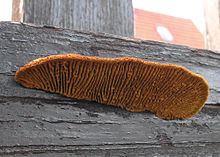Fence flake
| Fence flake | ||||||||||||
|---|---|---|---|---|---|---|---|---|---|---|---|---|

Fence leafy ( Gloeophyllum sepiarium ) |
||||||||||||
| Systematics | ||||||||||||
|
||||||||||||
| Scientific name | ||||||||||||
| Gloeophyllum sepiarium | ||||||||||||
| ( Wulfen : Fr. ) P. Karst. |
The fence leafy ( Gloeophyllum sepiarium , syn. Daedalea sepiaria , Lenzites crocata and L. sepiaria ) is a species of fungus from the family of leafy relatives (Gloeophyllaceae).
features
Macroscopy
The fence leaves form annual to perennial, very variable fruiting bodies : Depending on where they are grown, these are semicircular (on stick surfaces), fan-shaped, shell-shaped or console-shaped. On vertical substrates the fruiting bodies are often arranged in rows like bands. They can also lie completely flat ("resupinat") on the underside of the substrate . The top of the hat is initially curly-tomentose and becomes bald with age. The fruiting bodies are zoned and furrowed in a concentric manner. They are usually slightly hunched in the middle. The top of the hat is initially bright yellow-brown, later darker reddish-brown or rust-brown, with age and exposure to sunlight, the color can fade to gray tones or become completely black. The growth edge is still yellow to yellow-brown in actively growing fruit bodies. The hymenophore on the underside is reminiscent of lamellae, which are often cross-connected.
microscopy
The hyphae system is trimitic; in addition to thin to thick-walled, septate, buckle-bearing generative hyphae, there are also unseptate, thick-walled skeletal hyphae and connective hyphae. However, the connective hyphae are very sparse and can usually only be found in older areas of the trama.
Cystidia are common in the hymenium. They are thin to thick-walled in old age and measure 25–95 × 3–7 µm.
The basidia are narrow club-shaped and measure 18–40 × 4.5–7 µm. Some are greatly elongated and reach a length of up to 110 µm. They are usually four-pore and have a basal buckle.
The spores are cylindrical, colorless-hyaline, smooth, inamyloid and measure 8–11 (12) × 3–5 µm.
sexuality
The fence foliage is heterothallic and shows a bipolar cross type.
Species delimitation
The fence leaf is easily recognizable with its rust-brown color, the yellowish growth zone and the narrow lamellae (15–20 lamellae per cm on the edge of the hat). The fir foliage ( Gloeophyllum abietinum ) shows more warm brown fruiting body colors without a rust tone, no yellow growth zone and with only 8–13 lamellae per cm on the edge of the hat further away. The barbed pelvis (Gloeophyllum trabeum) is easily distinguishable by its lamellae, which are even more dense than those of the fence foliage, which anastomize much more and thus form labyrinthine pores. In addition, the top of the hat is smoother, not so tomentose, pale in color and the consistency is softer.
ecology
The fence foliage is a wood-dwelling saprobiont that mainly colonizes coniferous wood - especially spruce ( Picea ). But it has a very broad substrate spectrum, including spruce, fir ( Abies) , cypress ( Cupressus ), juniper ( Juniperus ), larch ( Larix ) and pine ( Pinus ), in North America also Douglas fir ( Pseudotsuga ), bald cypress ( Taxodium ) and Hemlock ( Tsuga ). The fence leaf also colonizes hardwoods such as alder ( Alnus ), birch ( Betula ), beech ( Fagus ), poplar ( Populus ), prunus , oak ( Quercus ), willow ( Salix ) and Sorbus , albeit less often in Europe .
The mycelium of the fungus causes intense brown rot in the affected wood . The mycelium grows - protected and invisible from the outside under the cover that has been fixed in the sun - in dead and debarked wood, which is particularly exposed to the sun and wind and which is strongly heated and dried out in summer. Built-in wood is also accepted as a substrate. Fence poles, railings, flower beds or sandpit borders, playground equipment, benches etc. are also populated. Apparently it cannot colonize coniferous wood impregnated with wood preservative in pressure vessels.
distribution
In Germany, the fence leaf can be found in suitable locations almost everywhere. The northern limit of the range is reached in Europe in Norway at 70 ° north latitude. Outside Europe, it is widespread in North and South America, Asia, and North and South Africa. It is less common in the Mediterranean region and appears to be absent from the Mediterranean islands, Portugal and Hungary.
meaning
The fence leaf is an important pest to wood. Due to his preference for sun-exposed, debarked wood, he often attacks built-in wood, which is then destroyed by the brown rot . Since the fungus first colonizes the inner, more humid areas and forms fruiting bodies relatively late, the infestation is usually only recognized at an advanced stage.
swell
literature
- German Josef Krieglsteiner (Ed.): The large mushrooms of Baden-Württemberg . Volume 1: General Part. Stand mushrooms: jelly, bark, prick and pore mushrooms. Ulmer, Stuttgart 2000, ISBN 3-8001-3528-0 .
- Josef Breitenbach, Fred Kränzlin (Ed.): Mushrooms of Switzerland. Contribution to knowledge of the fungal flora in Switzerland. Volume 2: Heterobasidiomycetes (gelatinous mushrooms), Aphyllophorales (non-leaf mushrooms), Gastromycetes (belly mushrooms). Mykologia, Luzern 1986, ISBN 3-85604-020-X .
- Peter Schütt, Hans J. Schuck, Bernd Stimm: Lexicon of tree and shrub species . The standard work of forest botany. Morphology, pathology, ecology and systematics of important tree and shrub species. Nikol, Hamburg 2002 (581 pages;).
Individual evidence
- ↑ a b c d e f g h i j k l Leif Ryvarden, Richard L. Gilbertson: European Polypores Part 1. Abortiporus-Lindtneria . In: Synopsis Fungorum . 1st edition. tape 6 . Fungiflora, Oslo, Norway 1993, ISBN 82-90724-12-8 , pp. 1-387 .
- ^ MK Nobles: Identification of cultures of wood-inhabiting Hymenomycetes . In: Canadian Journal of Botany . tape 43 , 1965, p. 1097-1139 .




